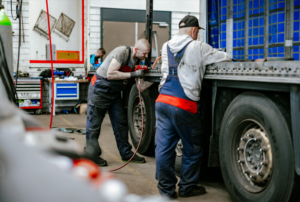In January 2014, Mayor Bill de Blasio announced a significant Vision Zero initiative for New York City with ambitious street re-design goals, new bike lanes, improved traffic rules, and better enforcement. Six years on, what does a Vision Zero NYC Fleet look like?
Vision Zero is notable for its focus on re-engineering roadways to make driving safer. However, vehicles and drivers also have a critical role to play. In 2014, the NYC Mayor’s Office of Operations introduced an inter-agency task force to spearhead Vision Zero. NYC Fleet at the Department of Citywide Administrative Services (DCAS) became one of the programme’s leading agencies, focusing on the fleet’s re-design to match roadway improvements.
NYC Fleet is the USA’s largest municipal fleet with more than 30,000 vehicles. NYC Fleet also partners in managing thousands of other vehicles, including the New York Housing Authority and the city’s almost 11,000 contracted school buses.
In the end, safety depends on the behaviours and interactions, each minute, of drivers, vehicles, cyclists, and pedestrians. NYC Fleet’s charge in Vision Zero is to aggressively advance the safe design of vehicles and train fleet operators and match, on the car and truck side, the work that City Department of Transportation (DOT) and NYPD are doing in road improvements and enforcement.
The fleet plan began with training. Each fleet operator spends a full day focused on safe driving and Vision Zero. They are also confronted by the stories of actual crashes in the hard-hitting film Drive Like Your Family Lives Here. So far, more than 65,000 staff from over 50 agencies have received training. DCAS recently developed an online version of the course to help address Covid-19 restrictions called Vision Zero Driver Safety Training Goes Online. DCAS and DOT also filmed a video to focus on safe driving for truck drivers and is testing virtual reality as a potential tool to improve hands-on driver training.
Increase focused driving
On the policy front, City DOT reduced the speed limit to 25 mph and introduced speed cameras while NYC Fleet took on the problem of distracted driving. A DCAS review found that distraction from hands-free use is just as potentially dangerous as hand-held phone use and barred it for city fleet operators. Our campaign is simple. The only safe driving is focused driving.
NYC Fleet doesn’t just instruct on behaviours, it also monitors and reports on them. Until adopting Vision Zero, the city had not collected crash information for agencies in one place. DCAS established the first CRASH database to enable the analysis of trends, including the agencies and vehicles involved in crashes, any resulting injuries, weather conditions, and what the driver was doing. NYC can spend upwards of US$125 million (£92 million) in litigation just for its fleet in any given year. Understanding trends helps inform steps to reduce fatalities and injuries and the associated costs and property damage.
Among many findings, CRASH tracking showed how prevalent rear-end crashes were in causing injuries and damage. Rear-ends are preventable through a combination of training, proper driving, and investment in technologies such as automatic braking systems.
NYC Fleet also tracks driving behaviours with the most extensive public vehicle live-tracking programme in North America, currently tracking 23,000 units. DCAS established a fleet command centre, called the FORT (Fleet Office of Real-Time Tracking). All through each day, agencies receive live alerts of speeding, failure to use seatbelts, possible crash situations, and potential misuse of fleet units. Agencies also receive regular Safety Index scoring by vehicle that includes speed, seatbelts, and crashes and potential indicators of unsafe driving such as hard braking, accelerating, harsh cornering and turns. The goal is to improve driving behaviours before they result in crashes.

Possibly the most critical innovation, however, is in the design of the NYC fleet vehicles. NYC operates more than 100 different types of units. Specifications are developed through technical supervisors from the vital fleet agencies such as NYPD, FDNY (Fire Department of New York), DSNY (Department New York City Sanitation), DOT, DEP (Department of Environmental Protection), Parks, Correction, and others. DCAS partnered with the Volpe Centre at US Federal DOT on a comprehensive plan to improve safety specifications, called the Vision Zero Safe Fleet Transition Plan (SFTP).
With DCAS, Volpe has interviewed all the agency specifications experts and carried out extensive safety research. The first report was on truck side-guards, the Volpe Final Report on Truck Sideguards for Vision Zero. While common in the UK and Europe, side rails are almost unheard of in North America. DCAS set out to install truck side-guards throughout its fleet through retrofits and new vehicle procurement. NYC also passed a local law requiring this innovation on all city fleet and commercial waste trucks. Through 2020, more than 3,500 city trucks (approx 80%) now have side-guards.

NYC received national recognition for this initiative in 2016. National legislation is now pending and is being pushed by the advocacy community.
Safety improvements on NYC fleet
In addition to truck side-guards, the Safe Fleet Transition Plan sets out a series of safety improvements throughout the NYC Fleet. The plan establishes required safety outfitting for new vehicle acquisitions and outlines practices that will be tested or implemented for target fleets.
SFTP investments include automatic braking, driver-alert systems, heated mirrors, back-up cameras and alerts, side-guards for trucks, telematics trackers, and car cams. In total, NYC Fleet has implemented more than 55,000 safety upgrades since 2017, and these efforts continue.

In early 2020, city trucks were involved in a series of tragic fleet events. Line-of-sight obstruction for truck operators is a crucial area of concern. In 2018, DCAS announced it would pursue high-vision trucks wherever possible. In conventional lorries, with the engine in front of the driver, line of sight can be 20 feet or more. High-vision trucks promise greatly improved sightlines. However, there is limited availability in the US. As DCAS pushes for more market offerings, fleet is also launching a retrofit programme of surround cameras for trucks. In 2020, DCAS procured 1,250 surround systems, which will be installed throughout 2021.
NYC Fleet is also partnering with US and City DOT on a longer-term project to study connected vehicle technology. NYC is one of three cities in the US implementing this programme, which will see up to 5,000 city fleet units retrofitted with technology that aims to test vehicle-to-vehicle and vehicle-to-infrastructure capacities.
Executive Order 53
One fleet can’t change vehicle design in the industry on its own. NYC Fleet’s drive for safer vehicles depends on these models being more widely available. To help spur change, Mayor de Blasio announced Executive Order 53 of 2020, which extends the Safe Fleet Transition Plan to private, non-profit, and other public fleets operating in NYC and widely promoting these life-saving steps.

NYC has also hosted a series of influential Fleet Safety Forums to bring advocacy, fleet, and industry groups together to prioritise safety. Commercial and public fleets can change the vehicle market by working together. Among the changes NYC Fleet would like to see is the separation of safety and luxury options in the sale of fleet vehicles. A fleet operator should not have to buy leather seats, a sunroof, and an entertainment package to get automatic braking, heated mirrors, and driver safety alerts on their vehicle.
Progression

All these efforts are aimed at one thing: reducing the instances and severity of crashes. While there is much more to do, NYC Fleet sees progress. Fatal vehicle events involving the non-emergency city fleet have declined over 75% since the initiative launched in 2014. Crashes and injuries per mile have also declined as reported in the fleet section of the City’s Mayor’s Management Report (MMR). Fleet achieved demonstrable improvements in safe driving behaviours after our first full year of live fleet tracking, though some gains have been lost during the Covid-19 pandemic.
For NYC and fleet, Vision Zero is a long-term commitment. It is also an example of how we can all work together to pursue common aims. NYC brought Vision Zero from Europe to the US, and now Vision Zero is spreading to other US cities. Fleets have a tremendous amount to learn from each other as we pursue our common service, safety, and sustainability goals.
For more information:
For more detail on the NYC Fleet Vision Zero efforts, please visit the Vision Zero section of our Fleet website You can also email [email protected] if you have any specific questions.
On Wednesday, February 10 at Noon EST NYC Fleet will join the Vision Zero Network and Together for Safer Roads to present a webinar on strategies for fleet safety and integrating fleet safety into your Vision Zero program.
Presenters will include Keith Kerman, Deputy Commissioner and Chief Fleet Officer for NYC Fleet, Alex Epstein of the US Department of Transportation Volpe Center, and Peter Binham from Transport for London.
More information about the webinar can be found here. The registration page can be found here.




